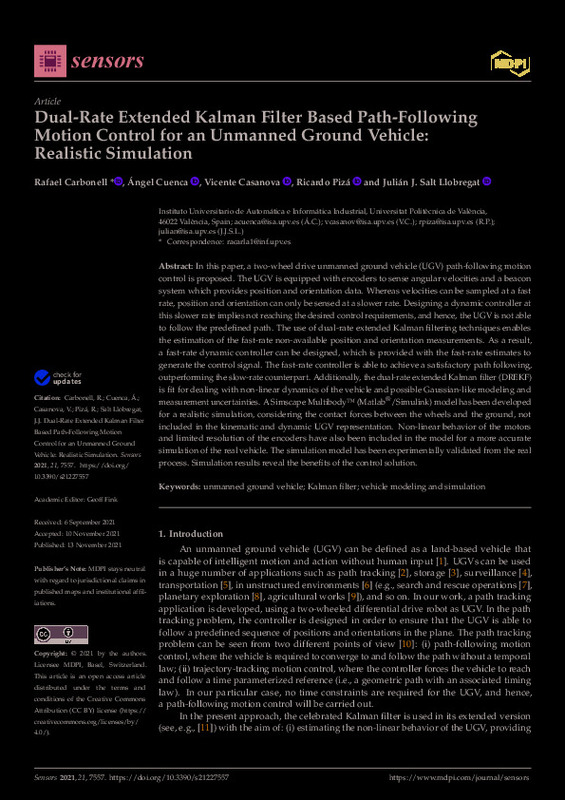JavaScript is disabled for your browser. Some features of this site may not work without it.
Buscar en RiuNet
Listar
Mi cuenta
Estadísticas
Ayuda RiuNet
Admin. UPV
Dual-Rate Extended Kalman Filter Based Path-Following Motion Control for an Unmanned Ground Vehicle: Realistic Simulation
Mostrar el registro sencillo del ítem
Ficheros en el ítem
| dc.contributor.author | Carbonell-Lázaro, Rafael
|
es_ES |
| dc.contributor.author | Cuenca, Ángel
|
es_ES |
| dc.contributor.author | Casanova Calvo, Vicente
|
es_ES |
| dc.contributor.author | Pizá, Ricardo
|
es_ES |
| dc.contributor.author | Salt Llobregat, Julián José
|
es_ES |
| dc.date.accessioned | 2022-10-07T18:06:51Z | |
| dc.date.available | 2022-10-07T18:06:51Z | |
| dc.date.issued | 2021-11-13 | es_ES |
| dc.identifier.uri | http://hdl.handle.net/10251/187286 | |
| dc.description.abstract | [EN] In this paper, a two-wheel drive unmanned ground vehicle (UGV) path-following motion control is proposed. The UGV is equipped with encoders to sense angular velocities and a beacon system which provides position and orientation data. Whereas velocities can be sampled at a fast rate, position and orientation can only be sensed at a slower rate. Designing a dynamic controller at this slower rate implies not reaching the desired control requirements, and hence, the UGV is not able to follow the predefined path. The use of dual-rate extended Kalman filtering techniques enables the estimation of the fast-rate non-available position and orientation measurements. As a result, a fast-rate dynamic controller can be designed, which is provided with the fast-rate estimates to generate the control signal. The fast-rate controller is able to achieve a satisfactory path following, outperforming the slow-rate counterpart. Additionally, the dual-rate extended Kalman filter (DREKF) is fit for dealing with non-linear dynamics of the vehicle and possible Gaussian-like modeling and measurement uncertainties. A Simscape Multibody (TM) (Matlab(R)/Simulink) model has been developed for a realistic simulation, considering the contact forces between the wheels and the ground, not included in the kinematic and dynamic UGV representation. Non-linear behavior of the motors and limited resolution of the encoders have also been included in the model for a more accurate simulation of the real vehicle. The simulation model has been experimentally validated from the real process. Simulation results reveal the benefits of the control solution. | es_ES |
| dc.description.sponsorship | Grant RTI2018-096590-B-I00 funded by MCIN/AEI/10.13039/501100011033 and by "ERDF Away of making Europe" and Grant PRE2019-088467 funded by MCIN/AEI/10.13039/501100011033 and by "ESF Investing in your future". | es_ES |
| dc.language | Inglés | es_ES |
| dc.publisher | MDPI AG | es_ES |
| dc.relation.ispartof | Sensors | es_ES |
| dc.rights | Reconocimiento (by) | es_ES |
| dc.subject | Unmanned ground vehicle | es_ES |
| dc.subject | Kalman filter | es_ES |
| dc.subject | Vehicle modeling and simulation | es_ES |
| dc.subject.classification | INGENIERIA DE SISTEMAS Y AUTOMATICA | es_ES |
| dc.title | Dual-Rate Extended Kalman Filter Based Path-Following Motion Control for an Unmanned Ground Vehicle: Realistic Simulation | es_ES |
| dc.type | Artículo | es_ES |
| dc.identifier.doi | 10.3390/s21227557 | es_ES |
| dc.relation.projectID | info:eu-repo/grantAgreement/AEI/Plan Estatal de Investigación Científica y Técnica y de Innovación 2017-2020/RTI2018-096590-B-I00/ES/DISEÑO EFICIENTE DE SISTEMAS DE CONTROL EN RED INALAMBRICA APLICADOS A UXVS UTILIZANDO TECNICAS DE CONTROL CON MUESTREO NO CONVENCIONAL Y BASADAS EN EVENTOS/ | es_ES |
| dc.relation.projectID | info:eu-repo/grantAgreement/AEI//PRE2019-088467//AYUDA PREDOCTORAL AEI-CARBONELL LAZARO. PROYECTO: DISEÑO EFICIENTE DE SISTEMAS DE CONTROL EN RED INALAMBRICA APLICADOS A UXVS UTILIZANDO TECNICAS DE CONTROL CON MUESTREO NO CONVENCIONAL Y BASADAS EN EVENTOS./ | es_ES |
| dc.rights.accessRights | Abierto | es_ES |
| dc.contributor.affiliation | Universitat Politècnica de València. Departamento de Ingeniería de Sistemas y Automática - Departament d'Enginyeria de Sistemes i Automàtica | es_ES |
| dc.description.bibliographicCitation | Carbonell-Lázaro, R.; Cuenca, Á.; Casanova Calvo, V.; Pizá, R.; Salt Llobregat, JJ. (2021). Dual-Rate Extended Kalman Filter Based Path-Following Motion Control for an Unmanned Ground Vehicle: Realistic Simulation. Sensors. 21(22):1-17. https://doi.org/10.3390/s21227557 | es_ES |
| dc.description.accrualMethod | S | es_ES |
| dc.relation.publisherversion | https://doi.org/10.3390/s21227557 | es_ES |
| dc.description.upvformatpinicio | 1 | es_ES |
| dc.description.upvformatpfin | 17 | es_ES |
| dc.type.version | info:eu-repo/semantics/publishedVersion | es_ES |
| dc.description.volume | 21 | es_ES |
| dc.description.issue | 22 | es_ES |
| dc.identifier.eissn | 1424-8220 | es_ES |
| dc.identifier.pmid | 34833632 | es_ES |
| dc.identifier.pmcid | PMC8624498 | es_ES |
| dc.relation.pasarela | S\449976 | es_ES |
| dc.contributor.funder | AGENCIA ESTATAL DE INVESTIGACION | es_ES |
| upv.costeAPC | 1785,39 | es_ES |








